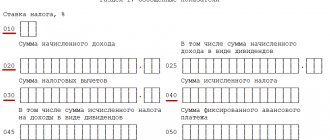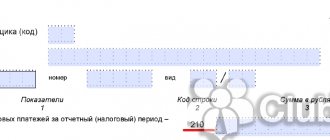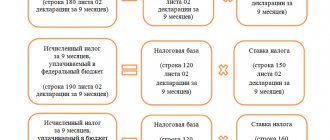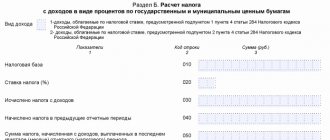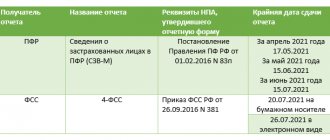Procedure for conducting a desk tax audit
The procedure for conducting a desk audit is established by Art.
88 Tax Code of the Russian Federation. Taxpayers submitting profit returns should pay attention to the following provisions of this procedure. 1. Only the declaration submitted to the tax authority is subject to verification (Clause 1, Article 88 of the Tax Code of the Russian Federation). However, if the declaration is not submitted, the tax authority has the right to cameralically, within the same time frame, check information about the taxpayer using the sources available to it (clause 2 of Article 88 of the Tax Code of the Russian Federation).
2. The audit is carried out without a special decision of the head of the tax authority (clause 2 of Article 88 of the Tax Code of the Russian Federation) and without notifying the taxpayer.
3. The period for conducting a desk audit is 3 months from the date of submission of the declaration (clause 2 of Article 88 of the Tax Code of the Russian Federation).
4. Upon receipt of a declaration with a loss, errors, discrepancies and inconsistencies with other information are identified, the tax authority sends the taxpayer a request to provide explanations for the identified inconsistencies or to make appropriate corrections to the declaration (clause 3 of Article 88 of the Tax Code of the Russian Federation).
5. Explanations must be submitted to the tax authority in any way available to the organization within 5 working days from the date of receipt of the request (clause 3 of Article 88 of the Tax Code of the Russian Federation).
6. In support of the data included in the explanations, the taxpayer has the right to additionally provide accounting and tax registers, as well as any other documents (clause 4 of Article 88 of the Tax Code of the Russian Federation).
7. If during a desk audit the taxpayer submits an updated tax return for the audited period, then the period for the desk audit begins to count anew from the date of submission of the updated declaration (clause 9.1 of Article 88 of the Tax Code of the Russian Federation).
See “A clarification submitted after delivery of the act of the Commission will not prevent a decision on it .
8. If an updated declaration is submitted 2 years after the deadline established for the submission of these reports for the corresponding reporting (tax) period, and the tax accrued in it is in a smaller amount or the amount of the loss is increased, then the tax authority has the right to demand not only explanations, but also primary documents (clause 8.3 of article 88 of the Tax Code of the Russian Federation).
9. From taxpayers enjoying benefits, the tax authority has the right to request documents confirming the right to use such benefits (clauses 6 and 12 of Article 88 of the Tax Code of the Russian Federation).
If no violations are identified during the desk audit, the desk audit is automatically completed without drawing up any additional documents. If tax authorities identify errors and/or contradictions in the declaration, a special procedure for interaction between controllers and the taxpayer is then applied (see below).
Disputes often arise between taxpayers and the Federal Tax Service regarding income tax. Find out how the latest judicial practice on this issue is shaping up from the analytical collection from ConsultantPlus. Get trial access to the system and study the material for free.
In what time frame must the income tax return be processed?
In accordance with clause 2, 10 art. 88 of the Tax Code of the Russian Federation, a “camera meeting” on income tax is carried out within three months from the date the taxpayer (or tax agent) submits a tax return (calculation), unless otherwise provided by this paragraph.
According to Art. 6.1 of the Tax Code of the Russian Federation, the period begins on the next day after the calendar date or the occurrence of an event (action) that determines its beginning (clause 2). A period calculated in months expires on the corresponding month and day of the last month of the term. If the end of the period falls on a month in which there is no corresponding date, then the period expires on the last day of that month (clause 5).
Please note that if the declaration is submitted by mail, the day it is sent and the day it is received by the inspection do not coincide. In this case, the period must be counted from the date of receipt of the declaration by the Federal Tax Service (see letters of the Ministry of Finance of Russia dated December 22, 2017 No. 03 02 07/1/85955, Federal Tax Service of Russia dated July 16, 2013 No. AS-4-2/12705 (clause 2.2)) .
Let’s assume that the Federal Tax Service received an income tax return for the nine months of 2022 on 10/25/2019. Three months expire on 01/25/2020. Since it is Saturday, the check deadline is 01/27/2020.
So, the duration of the CNI is three months. This period cannot be extended or suspended.
Moreover, if before the end of the tax return the taxpayer submits an updated declaration (calculation), the tax return of the previously submitted declaration (calculation) is terminated and a new tax return begins based on the “clarification”. Termination of the tax return means the termination of all actions of the tax authority in relation to the previously submitted declaration (calculation). At the same time, documents (information) received by the tax authority within the framework of the terminated tax compliance process can be used when carrying out tax control measures in relation to the taxpayer (clause 9.1 of article 88 of the Tax Code of the Russian Federation).
Note. According to the Ministry of Finance, violation of procedural deadlines during tax control activities is not a significant violation entailing the unconditional cancellation of the tax authority’s decision made based on the results of a tax audit (Letter No. 03 02 07/1/18400 dated March 23, 2018).
What should a taxpayer do if errors and contradictions are identified in the declaration?
If, despite the explanations provided and additional tax control measures, the tax authority considers a violation to have been identified, then within 10 working days from the date of completion of the audit it draws up a desk tax audit report. The report must be delivered to the taxpayer no later than 5 business days after the date of preparation.
Within 1 month, the taxpayer has the right to submit objections to the desk audit report. Objections must be considered by the head of the tax authority within 10 working days after the deadline for submitting objections. Based on the results of this review, a decision may be made to prosecute or refuse to prosecute. The head of the tax authority may also make a decision to extend the inspection period (for a period of no more than 1 month) and to carry out additional tax control measures.
Taking into account the above, it becomes obvious the importance of independently checking the profit declaration before submitting it to the tax authorities and the readiness to provide comprehensive explanations in response to a request from the tax authorities.
Find out how to calculate income tax here.
Requesting documents from the taxpayer within the framework of the KNP for income tax
Does the Federal Tax Service have the right to request additional information and documents?
In accordance with paragraph 7 of Art. 88 of the Tax Code of the Russian Federation, when conducting a tax inspection, the tax authority does not have the right to request additional information and documents from the taxpayer if:
— otherwise not provided for in this article;
— the submission of such documents together with the tax return (calculation) is not established by the Tax Code of the Russian Federation.
Let's consider in what cases Art. 88 of the Tax Code of the Russian Federation provides for the right of tax authorities to request additional information.
Firstly, according to clause 8.2 of this article, when conducting a tax return on income tax of a participant in an investment partnership agreement, the tax authority has the right to:
- request from him information about the period of his participation in such an agreement, about his share of the profits (expenses, losses) of the investment partnership;
— use any information about the activities of the investment partnership available to the tax authority.
Secondly, by virtue of clause 8.3 of Art. 88 of the Tax Code of the Russian Federation, the Inspectorate of the Federal Tax Service has the right to request documents when conducting a tax return on the basis of a “clarification” submitted after two years from the date established for filing a declaration (calculation) for income tax for the corresponding reporting (tax) period, in which:
— the amount of tax payable to the budget system of the Russian Federation has been reduced;
— the amount of the resulting loss has been increased compared to the previously submitted tax return (calculation).
In this case we are talking about the claim:
— primary and other documents confirming changes in information in the relevant indicators of the tax return (calculation);
— analytical tax accounting registers, on the basis of which the indicated indicators are formed before and after their changes.
Thirdly, according to clause 8.8 of Art. 88 of the Tax Code of the Russian Federation when conducting a CNI income tax return in which an investment tax deduction (INV) is declared, provided for in Art. 286.1 of the Tax Code of the Russian Federation, the tax authority has the right to require the taxpayer to provide, within five days, the necessary explanations regarding the application of the INV, and (or) to request, in the prescribed manner, from the taxpayer primary and other documents confirming the legality of the application of such a tax deduction.
In addition, as noted above, when conducting a tax return exercise, the tax authority does not have the right to request additional information and documents from the taxpayer if the submission of such documents along with the tax return (calculation) is not provided for by the Tax Code of the Russian Federation. Paraphrasing this provision, we find that if the Tax Code of the Russian Federation provides for the submission of certain documents along with the tax return (calculation), and the taxpayer “forgot” them, then the Federal Tax Service has the right to demand the submission of such documents.
For example, according to clauses 7, 8 of Art. 262 of the Tax Code of the Russian Federation, a taxpayer who incurs R&D expenses according to the list established by the Government of the Russian Federation has the right to take these expenses into account for tax purposes using a coefficient of 1.5. When using this right, the taxpayer submits to the tax authority a report on completed developments simultaneously with a tax return based on the results of the tax period in which they were completed.
Key points of income tax audit
Let us dwell on the most important points that occur when checking income taxes for most organizations. We provide links to the lines of the profit declaration in relation to its form, approved by order of the Federal Tax Service of Russia dated September 23, 2019 No. ММВ-7-3/ [email protected]
1. If the declaration is filled out manually, it must be checked for the absence of arithmetic errors and for compliance of the amounts included in sheet 02 with the amounts calculated in the corresponding appendices to sheet 02. When automatically filled out in an accounting program and in electronic reporting systems, such a check is usually present .
2. If a tax benefit is claimed or the rate is reduced, the taxpayer must be prepared to provide explanations and copies of documents confirming the right to apply the benefits.
3. Income from sales during an income tax audit is usually reconciled by tax authorities with income reflected in the declaration (or in declarations, taking into account the comparability of periods) for VAT.
In comparison with the VAT return, questions may arise in the following cases:
- Availability of income subject to VAT and not subject to income tax (for example, in the case of gratuitous transfer of property).
- Carrying out operations by the organization that are not subject to VAT. In this case, the taxpayer should not forget about the need to fill out Section 7 in the VAT return, which reflects data on transactions that are not subject to VAT.
- Carrying out transactions by the organization that are taxed at a 0% VAT rate. Here you need to be prepared to systematically provide explanations for discrepancies due to the fact that when a 0% rate is applied, the period for confirming the right to apply this rate does not always coincide with the shipment period. As a rule, there is a balance with unconfirmed right of application at the beginning of the compared period, there are discrepancies due to confirmation during the period and, as a result, there are discrepancies at the end of the compared period. This circumstance (with the attachment of tax registers reflecting sales broken down by VAT rates, and calculations of VAT distribution depending on the fact of confirmation of the right to a 0% rate, from which the difference in sales volumes becomes clear) will need to be explained to the tax authorities.
- In the non-operating income of the organization, there is income that is subject to VAT, but in the profit declaration does not fall into the lines of decoding revenue from sales. In this case, the taxable base for VAT will be greater than the proceeds from sales in the profit declaration. This will also require clarification with the attachment of tax registers.
4. Explanations will be required for the total loss of the reporting period and the losses reflected in Appendix 3 to Sheet 02 (in particular, losses from service production facilities and farms, from the sale of depreciable property, from the exercise of the right to claim debt).
Tax authorities treat declarations with a loss with increased attention. In order not to attract the attention of inspectors, many taxpayers do not show losses in their declarations. Find out how to properly get rid of a tax loss in the ConsultantPlus material by getting trial access for free.
You can find a sample explanation of losses in the material “Explanatory note to the tax office upon request - sample” .
5. When filling out data on advance payments accrued for the reporting (tax) period (lines 210, 220, 230 of sheet 02), it is necessary to check the presence of updated declarations that may affect the amount of advance payments.
See also the material “Updated declaration: what does an accountant need to know?” .
6. If an organization is a payer of any taxes other than income tax and VAT (for example, property tax), then on line 041 in Appendix 2 to Sheet 02 it must reflect the amount of taxes accrued for the taxable period. Missing data on this line will result in the need for additional clarification.
7. Explanations will most likely be requested by the tax authorities if the organization receives targeted funding and fills out sheet 07 of the profit declaration, especially if significant amounts are reflected in it.
8. When drawing up a profit declaration for the tax period (year), it is necessary to check whether the data in the profit declaration are consistent with the financial statements:
- the amount of income tax accrued for the year in the declaration and in the profit and loss statement in the line “Current income tax” must match;
- the differences between accounting and tax profits must have real explanations reflected in the tax registers.
9. When calculating the distribution of income tax payments and advance payments between separate divisions (Appendix 5 to Sheet 02), it is recommended to pay special attention to the following points:
- the correctness of calculation of shares of the tax base;
- compliance of the sum of the tax bases of the divisions with the general tax base of the organization;
- calculation of advance payments for the next period, the amount of which for each separate division is determined by multiplying the total amount of advance payments accrued for the next period for the organization by the share of the tax base of the division.
In most cases, after exhaustive explanations that do not contradict the data of the declaration, the questions are removed by the tax authorities. At the same time, errors in filling out the declaration, associated with incorrect reflection of amounts on its lines, but not leading to a distortion of the final amount of accrued tax, can also be explained in the explanations. In this case, an updated declaration will not be required (Clause 1, Article 81 of the Tax Code of the Russian Federation).
How to independently check a declaration before sending it to the inspectorate is discussed step by step in the ConsultantPlus ready-made solution. Get trial access and study the material for free.
Registration
Taxpayers strive to reduce the tax burden, and employees of the Federal Tax Service strive to increase the level of tax collection. The main tool of inspectors is inspection.
They have two types of inspections at their disposal: desk and on-site. The main dangers of additional assessment of income tax lie in wait for an organization during an on-site audit, when tax authorities are looking for any ways not only not to recognize expenses, but also to accrue additional income. But the inspectorate most often makes a decision to schedule an on-site inspection based on the results of a desk inspection.
According to the rules of a desk audit of corporate income tax (Article 88 of the Tax Code of the Russian Federation), the inspector may request additional documents from the person being inspected if there are inconsistencies and errors in the declaration. This means that in order to reduce the risk, you need to pay special attention to the accuracy of the report. To do this, you need to know how the inspector checks the income tax return in order to select a candidate for an on-site audit.
First, the inspector analyzes the declaration indicators for the fulfillment of control relationships (the connection of individual data with each other). At the same time, he checks individual indicators for compliance with Chapter 25 of the Tax Code of Russia.
If a discrepancy or lack of logical connection is discovered between tax and (or) accounting reporting indicators, the company will be asked for clarification on the procedure for forming individual amounts of income and expenses, as well as transactions, the financial results of which are taken into account when calculating the tax base. If the inspector has reason to believe that the tax base is underestimated, he will request primary documents.
The tax office will definitely require clarification if the following is stated in the tax return:
- benefits and reduced rates;
- loss from financial and economic activities, including certain transactions, the financial result of which is determined according to special rules;
- targeted financing funds.
Of the above, the main criterion for ordering an on-site inspection is the presence of a loss. Therefore, it is worth planning your activities in such a way as to always have a profit - small but stable.
In the notes to the annual report, explain the procedure for applying tax benefits. Explain individual gains and losses, indicating how tax was calculated in these cases.
Note that some indicators of accounting and tax reporting cannot be correlated.
For example, depreciation bonus (clause 9 of article 258 of the Tax Code of the Russian Federation). It is not used in accounting. But if in the explanations to the balance sheet and the financial results statement in relation to fixed assets, the “Received” column is not filled in, and the depreciation bonus is declared in the declaration (lines 042, 043 of Appendix 2 to sheet 02), there will definitely be questions: after all, in such a situation, bonuses nowhere to come from.
Explanations will also be requested if the profit figures in the accounting and tax statements differ significantly or if the financial statements show a profit and the tax return shows a loss. If the company applies PBU 18/02 “Accounting for calculations of corporate income tax” (approved by order of the Ministry of Finance of the Russian Federation dated November 19, 2002 No. 114n), the reasons for these deviations can be seen both in the balance sheet and in the income statement. And in the explanations to the annual report, it is better to immediately decipher the list of deferred tax liabilities, deferred tax assets, and permanent tax liabilities.
Results
To easily pass a desk audit of your income tax return, check arithmetic errors and basic control ratios in advance. In addition, be prepared to provide the tax authorities with explanations and documents if you apply benefits for this tax, received targeted funding, etc.
Sources:
- Tax Code of the Russian Federation
- Order of the Federal Tax Service of Russia dated September 23, 2019 N ММВ-7-3/ [email protected]
You can find more complete information on the topic in ConsultantPlus. Free trial access to the system for 2 days.
